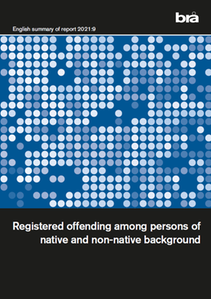New study from Brå: Registered offenders among persons of native and non-native background
August 25, 2021
A new study from The Swedish National Council for Crime Prevention, Brå, shows that the proportion of the population registered as suspected offenders has declined over the period 2007–2018 among persons of both native and non-native background.
The risk of being registered as an offender is greatest among persons born in Sweden to two non-native parents, followed by persons born abroad. The difference between different groups in the risk of being registered as a suspected offender is due, inter alia, to differences in the different groups’ age distributions. For example, those born in Sweden to two non-native parents include a larger proportion of young people by comparison with those born in Sweden to two native-born parents, and the proportion who are registered as suspected offenders is in general considerably greater among youths and young adults than among older adults.
During the period 2007–2018, the proportion of the population registered as suspected offenders has decreased in all of the groups examined in the study. Among Swedish-born persons with two native-born parents, the proportion registered as suspected offenders has declined from 1.6 to 1.4 percent, and among persons born in Sweden to one non-native parent it has declined from 3.3 to 2.6 percent. Among those born in Sweden to two non-native parents, the proportion registered as suspected offenders has declined from 5.3 to 4.7 percent, and among persons born abroad from 4.0 to 3.6 percent.
For some offence types, however, the proportion of the population registered as offenders has increased between 2007and 2018. The proportion registered as suspects in connection with drug offences has increased in all of the groups examined, for example, and the proportion registered in connection with attempted or completed homicide offences has increased among those born in Sweden to two non-native parents.
The study has also examined the relative risk of being registered as a suspected offender, i.e. how the level of risk in different groups compares with that of a reference group.
- When we compare the different groups with the chosen reference group, which is comprised of those born in Sweden to two native-born parents, we see that this relative risk was much the same in 2018 as it was in 2007, says David Shannon, Head of Division, Brå.
The risk of being registered as a crime suspect is 2.5 times as high among persons born abroad as it is among persons born in Sweden to two native-born parents. For persons born in Sweden to two non-native parents, the risk is just over 3 times as high.
- Even though persons born in Sweden to two non-native parents are at relatively high risk of being registered as suspected offenders, they constitute a small group within the population as a whole, and they account for only a small proportion of all registered offences, says David Shannon.
The study is primarily descriptive. At the same time, some of the analyses employ statistical standardisation to take account of between-group differences in a number of background factors: Age, gender, disposable income, level of education, and the type of municipality in which individuals live. These analyses show that between-group differences in the age distribution are an important factor. The proportion of youths and young adults is greater among those born abroad, and particularly among those born in Sweden to two non-native parents, and young people are generally suspected of offending considerably more often than older persons. The analyses show that differences in the risk of being registered as a suspected offender are also associated with between-group differences in levels of income and education.
About the study
The study is primarily descriptive and includes three sub-studies, each of which has a different focus. Sub-study 1: The proportions registered as suspected offenders during the period 2015–2018, Sub-study 2: Trends in the proportions registered as suspected offenders during the period 2007–2018, Sub-study 3: Trends in the proportions of registered offences linked to suspected offenders from different population groups during the period 2007–2018. The study employs data from Brå on persons registered as suspected offenders, and Statistics Sweden’s official classification of native and non-native background, which is based on four groups: Born in Sweden, both parents born in Sweden; Born in Sweden, one parent born abroad; Born in Sweden, both parents born abroad; Born abroad.
Contact
Brå’s press service, e-mail: press@bra.se; tel: +46 72 99 58 500


